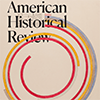The March 2023 issue of the AHR opens with James H. Sweet’s (Univ. of Wisconsin–Madison) presidential address, “Slave Trading as a Corporate Criminal Conspiracy, from the Calabar Massacre to BLM, 1767–2022.” Sweet traces Liverpool’s Lace family from their enthusiastic participation in the Atlantic slave trade in the 18th century, through their curation of historical memory of that participation in the 19th and 20th centuries, to the rebranding of the family law firm as“BLM” in 2014. He uses this narrative of the “politics of everyday life” to call for a new framework for reparations to the descendants of enslaved Africans. Reparations, Sweet concludes, require “dismantling the systems that raised the need for repair in the first place.”
 The return of the Elgin Marbles now housed in London’s British Museum has been the fraught subject of diplomatic negotiation between the Greek and British governments for decades. Recovering the complex histories of cultural repatriation are among the subjects that have more recently pushed international and transnational historians to develop novel conceptual and methodological approaches in their research and scholarship. The March AHR History Lab features a forum that brings together reflections by 12 historians on their own work in this field. Image courtesy Tony French/Alamy Stock Photo.
The return of the Elgin Marbles now housed in London’s British Museum has been the fraught subject of diplomatic negotiation between the Greek and British governments for decades. Recovering the complex histories of cultural repatriation are among the subjects that have more recently pushed international and transnational historians to develop novel conceptual and methodological approaches in their research and scholarship. The March AHR History Lab features a forum that brings together reflections by 12 historians on their own work in this field. Image courtesy Tony French/Alamy Stock Photo.
Like Sweet’s address, much of the March issue coalesces around issues of slavery, trade, and justice over the long 19th century. In “Everyday Economic Justice,” Louise Walker (Northeastern Univ.) looks at a classic problem with contemporary resonance: What happens when people don’t pay their debts? Focusing on new forms of juridical arbitration in Mexico under the 1812 Cádiz Constitution, she uses microeconomic history—the study of the economic relationships, decisions, and actions of people, households, and small enterprise—to examine the cases of tens of thousands of residents in Mexico City from 1813 to 1863. Walker shows that this system was relatively effective for ordinary people and operated across gender lines in surprisingly fair-minded ways, giving it a broad popular legitimacy.
Ariel Ron’s (Southern Methodist Univ.) “When Hay Was King” urges historians to pay more attention to the trade patterns, developmental state policies, and nationalist economic ideologies that generated distinctly national, as opposed to global, economic spaces. Hay was the linchpin of the 19th-century US industrial energy regime, he argues, but it was largely ignored by contemporaries. The magnitude and importance of hay production only became clear with a detailed federal agricultural census in 1850, when hay was drafted into a wide-ranging debate on economic development, with “King Hay” in the North emerging as a foil for “King Cotton” in the South.
Lauren R. Clay’s (Vanderbilt Univ.) “Liberty, Equality, Slavery” examines a dispute in Paris during the winter of 1789–90 over the future of the slave trade. Countering a historiographical consensus that French revolutionaries never confronted the issue, Clay looks beyond the National Constituent Assembly to reveal debates that played out in correspondence, legislative committees, and private meetings, all largely shielded from public view. These became engines for political innovation and engaged nonelected political actors in the lawmaking process. Faced with bankruptcy, Clay argues, revolutionaries voted overwhelmingly to reconcile liberty, equality, and slavery, establishing precedents for future regimes.
What happens when people don’t pay their debts?
In “Becoming Elizabeth,” Megan Robb (Univ. of Pennsylvania) traces the life of a late 18th-century Mughal woman who lived with and bore children by a British East India Company supervisor and later followed him to Britain, changing her name and converting to Christianity. Although these kinds of cohabitations and travels were common in this period, scholars have often used the East India Company archives to compensate for the notorious dearth of information about these native women’s lives. In this article, Robb offers a textual-material analysis of a more diverse range of sources from a family archive, including 18th- and early 19th-century private correspondence in English and Persian as well as a material analysis of paintings, jewelry, textiles, and a penmanship book to offer new insight into the complex and embodied processes of Anglicization under British empire.
In “Writing to Undo,” Giora Sternberg (Univ. of Oxford) examines protestations, a genre of early modern documents intended to counter the consequences of coercive forces. He draws on a variety of French case studies to examine them as material objects and verbal texts, following them throughout their life cycle and exploring their producers, protagonists, and functions. Sternberg focuses on both the micro and macro levels, exploring cases of public protestation in the struggle of children against the abuses of patriarchal and familial authority and the subversive uses of protestation in constitutional crises of absolute monarchy.
The two final articles of the issue focus on transnational histories of humanitarianism and rights questions in the 20th century. Rotem Kowner’s (Univ. of Haifa) “A Holocaust Paragon of Virtue’s Rise to Fame” examines how Sugihara Chiune, a Japanese consul in Lithuania who issued transit visas to mostly Jewish Polish refugees on the eve of World War II, was transformed from a completely unknown figure into a world-famous symbol of Holocaust-era heroism. Kowner focuses on the transnational mechanisms that facilitated this transformation as well as on the motives in three countries most involved in the commemoration—Japan, Israel, and Lithuania. In doing so, he seeks to uncover the crosscultural theoretical underpinnings of heroism and its memory.
Finally, in “‘Tunisian Islam,’ Women’s Rights, and the Limits of French Empire in Twentieth-Century North Africa,” Julian Weideman (Univ. of British Columbia) shows that geographies of Muslim scholarship in colonial Tunisia exceeded both the national boundaries and the territory of the French empire, with Muslim intellectuals in Tunisia under French rule actively pursuing multidirectional exchange with their colleagues in Egypt and the wider Middle East. This context reveals the French idea of a singular “Tunisian Islam” to be specious and far from durable; after independence in 1956, the Tunisian state fused national Islam with the promotion of women’s rights. And yet, Weideman argues, the intellectual life evident under the French protectorate persisted after independence, raising questions about the tenability of the independent Tunisian state’s version of national Islam.
Transnational histories also shape the AHR History Lab. It opens with “On Transnational and International History,” a forum organized by Paul Thomas Chamberlin (Columbia Univ.) that brings together the reflections of 12 historians. In 2006, the AHR published “On Transnational History,” a conversation that remains one of the journal’s top downloaded articles. Almost 20 years later, this forum asks what we should make of the transnational turn and how it has informed historical practice. The contributors capture the challenges and satisfactions of working on a transnational canvas drawing on their own scholarship that spans the globe from the Middle Ages to the 20th century.
The Odeuropa team returns with their third contribution. In “More than the Name of the Rose,” they explore how to make computers read, see, and organize smells. Focusing on their efforts to design AI strategies to capture references to historical smells from digital heritage collections, the team provides a step-by-step guide for extracting smell-related information from text and images and encode them in visual graphs that can allow historians to follow olfactory practices over time and space. Their discussion is easy to follow and revelatory, especially for historians who do not typically use quantitative methods. Also in the March lab are two History Unclassified articles. Arie M. Dubnov (George Washington Univ.) and Basma Fahoum’s (Stanford Univ.) “Agnotology and Reckoning with the Past in Palestine/Israel” revisits the so-called “Teddy Katz affair,” a heated debate that first erupted in 2000 about a master’s thesis that relied heavily on oral testimonies and concluded that war crimes against Palestinians were committed during the 1948 War. In her “Frustration, Joy, and Shards of Fact,” Mary Klann (Univ. of California, San Diego) explores the connections between archival research and teaching as an adjunct faculty member and mother that takes the form of an “I-Search Paper,” a first-person account of the research process.
Mark Philip Bradley is editor of the American Historical Review.
Tags: AHA Activities American Historical Review Africa Asia/Pacific Europe Latin America Middle East North America Cultural History Economic History Political History Social History

This work is licensed under a Creative Commons Attribution-NonCommercial-NoDerivatives 4.0 International License. Attribution must provide author name, article title, Perspectives on History, date of publication, and a link to this page. This license applies only to the article, not to text or images used here by permission.
The American Historical Association welcomes comments in the discussion area below, at AHA Communities, and in letters to the editor. Please read our commenting and letters policy before submitting.
Comment
Please read our commenting and letters policy before submitting.










